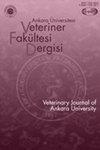Molecular characterization of antibiotic resistance, aminoglycoside and PmrA genes among foodborne and clinical Acinetobacter spp.
IF 0.9
4区 农林科学
Q3 VETERINARY SCIENCES
引用次数: 0
Abstract
The assessment of antibiotic resistance and related genes of foodborne Acinetobacter spp. and the analysis of whether they are genetically related to clinical infection-agent strains are crucial in terms of sustainability of food safety. The study at hand investigated antibiotic resistance, aminoglycoside-modifying enzyme (AME), and colistin resistance (PmrA) genes, clonal relationships while evaluating a possible correlation between antibiotic resistance and related genes between 27 foodborne and 50 clinical Acinetobacter spp. in Turkey. Antimicrobial susceptibilities, (AME), PmrA genes, and clonal relatedness of the strains were performed by disc diffusion, PCR, and Pulsed Field gel Electrophoresis (PFGE) methods, respectively. The aph-AI, aph-6, anth (3’’)-I, aadA1, aadB and PmrA genes were found as (24, 48%), (11, 22%), (7, 14%), (1, 2%), (2, 4%), and (46, 92%) respectively in clinical strains. This rate was found as (14, 51.9%), (16, 59.3%), (19, 70.4%), (2, 7.4%), (0, 0%), and (27, 100%) respectively in foodborne isolates. A positive correlation existed between the number of aph-AI gene positivity and trimethoprim-sulfamethoxazole and gentamycin resistance; anth (3’’)-I gene positivity, and colistin resistance; PmrA gene positivity and piperacillin-tazobactam, ceftazidime, meropenem, amikacin, and imipenem resistance in clinical strains (P食源性和临床不动杆菌耐药、氨基糖苷和PmrA基因的分子特征。
评估食源性不动杆菌的抗生素耐药性及其相关基因,分析其是否与临床感染因子菌株存在遗传相关性,对食品安全的可持续性至关重要。该研究调查了土耳其27种食源性不动杆菌和50种临床不动杆菌之间的抗生素耐药性、氨基糖苷修饰酶(AME)和粘菌素耐药性(PmrA)基因的克隆关系,同时评估了抗生素耐药性和相关基因之间的可能相关性。分别采用圆盘扩散法、PCR法和脉冲场凝胶电泳法(PFGE)检测菌株的抗菌敏感性、AME、PmrA基因和克隆亲缘性。在临床菌株中发现aph-AI、aph-6、anth(3”)-I、aadA1、aadB和PmrA基因分别为(24.48%)、(11.22%)、(7.14%)、(1.2%)、(2.4%)和(46.92%)。食源性分离株的检出率分别为(14.51.9%)、(16.59.3%)、(19.70.4%)、(2.7.4%)、(0.0%)和(27.100%)。aph-AI基因阳性数与甲氧苄啶-磺胺甲恶唑和庆大霉素耐药性呈正相关;anth(3”)-I基因阳性,与粘菌素耐药;PmrA基因阳性与临床菌株哌拉西林-他唑巴坦、头孢他啶、美罗培南、阿米卡星和亚胺培南耐药的关系(P
本文章由计算机程序翻译,如有差异,请以英文原文为准。
求助全文
约1分钟内获得全文
求助全文
来源期刊
CiteScore
1.50
自引率
0.00%
发文量
44
审稿时长
6-12 weeks
期刊介绍:
Ankara Üniversitesi Veteriner Fakültesi Dergisi is one of the journals’ of Ankara University, which is the first well-established university in the Republic of Turkey. Research articles, short communications, case reports, letter to editor and invited review articles are published on all aspects of veterinary medicine and animal science. The journal is published on a quarterly since 1954 and indexing in Science Citation Index-Expanded (SCI-Exp) since April 2007.

 求助内容:
求助内容: 应助结果提醒方式:
应助结果提醒方式:


